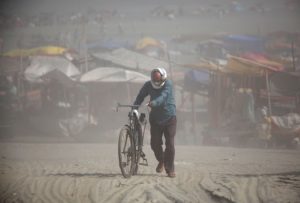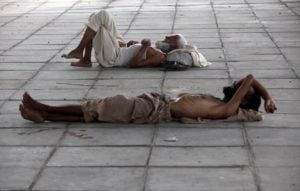Researchers have stated that climate change made the heatwave that hit Bangladesh, India, Thailand and Laos in April 2023 at least 30 times more likely. On 15 April, Thailand recorded its hottest ever temperature, when the city of Tak reached 45.4 degrees Celsius, and Vientiane, the capital of Laos, experienced its hottest day ever. Several cities in northern and eastern India saw temperatures surpass 44°C.
In a report on the heatwave, an international team of scientists state that the April heatwave triggered severe problems across South and Southeast Asia, from spikes in hospitalisations for heat stroke in Navi Mumbai, to school closures in eastern India, and forest fires across India, Thailand and Laos.
As the climate crisis gathers pace, Heat Action Plans (HAPs) – sets of measures for authorities to take to reduce citizens’ exposure to dangerous heat – are becoming an urgent necessity across South and Southeast Asia. Unfortunately, many countries in the region have yet to develop such plans, and experts have found that even where they exist, they are underfunded and lack provisions for poorer communities.
Heat Action Plans a necessary first step
At the report’s launch on 17 May, scientists from the World Weather Attribution group who studied the April heatwave pointed out that at present, official heat action plans are only in place in India. Bangladesh, Thailand and Laos, which were all hit hard by the April heatwave, have none.
In early 2021, ICLEI, a global organisation that coordinates sustainable development action by local governments, worked with the Red Cross Red Crescent Climate Centre to prepare an unofficial HAP for Rajshahi in western Bangladesh. But the extent to which this is being followed by the municipal government is unclear. Dhaka, Bangladesh’s capital, also appointed a ‘chief heat officer’ in May. The effect of this appointment remains to be seen.
Chaya Vaddhanaphuti, a lecturer in geography at Chiangmai University in Thailand and a co-author of the April heatwave report, said at its launch that Thailand has a national-level warning system for heatwaves but no specific plan in place for vulnerable populations. Laos does not have a plan at all, he added.
Key gaps in India’s plans need to be addressed
India has so far been ahead of the curve. The country’s first Heat Action Plan, launched in Ahmedabad, Gujarat, in 2013 and updated in 2019, has been credited with preventing many cases of heatstroke, thanks to actions including text message warnings sent to everyone in the city when temperatures are forecast to exceed 40°C, as well as moves targeted at poor and vulnerable communities, such as painting tin and asbestos roofs white to reflect the heat. A zero-cost decision to keep public parks unlocked throughout the day has enabled roadside vendors and construction workers to benefit from the shade of trees during the hottest hours.
Ahmedabad still has many heat-related urban planning issues. For example, there are few green spaces and fewer energy efficient buildings, and an overabundance of concrete and glass structures worsens the urban heat island effect. But the city made a start with its HAP.
Other municipalities in India have also implemented Heat Action Plans since 2013, but their design leaves a great deal to be desired. In a March 2023 report which analysed 37 city, district and state HAPs in India, the New Delhi-based think tank Centre for Policy Research (CPR) stated: “Most HAPs are not built for local context and have an oversimplified view of the hazard … [and] nearly all HAPs are poor at identifying and targeting vulnerable groups. Only two of 37 HAPs explicitly carry out and present vulnerability assessments.”
The CPR report also found that HAPs in India are underfunded. Most do include capacity building in crucial sectors such as healthcare and construction, but not government departments or civil society. The report also points out that HAPs are guidelines rather than legal mandates, which means bureaucrats may not be accountable for delays in implementation. In many cases, important provisions of HAPs have been implemented only if a bureaucrat or a politician felt like doing so.
Heatwaves set to get worse
These gaps in implementation of heat action plans matter because extreme heat is going to become an ever-bigger problem for South and Southeast Asia. The scientific report on the recent heatwave found that heatwaves in India and Bangladesh are around 2°C hotter than they would have been without human-induced climate change, and that if global temperature rise reaches 2°C above pre-Industrial Age levels, humid heatwaves like this April’s will likely occur at least once every two years.
The study found that in Laos and Thailand, an event like the recent record humid heatwave would have been nearly impossible without the influence of climate change, and if global temperature rise reaches 2°C, they will become around 10 times more likely.
The authors of the World Weather Attribution study used a heat index that integrates temperature and humidity in determining the effect of heat on humans, and the danger posed. Heat is more dangerous in humid conditions, since sweating, which cools the human body, becomes less effective in high humidity. In highly humid conditions, human survival becomes difficult after a few hours at 35 ˚C.
As yet, there is no humidity index that can be used in official forecasts in India, although the India Meteorological Department (IMD) is now developing one. Most experts agree that such an index would help city and state government officials prepare better for heatwaves. The challenge is to develop a reliable index in the absence of studies on changes in humidity in different parts of the country, according to Mrityunjoy Mohapatra, head of IMD, speaking at a recent media workshop.
As governments around the world fail to adequately control emissions of the greenhouse gases causing climate change, average global temperatures are now nearly 1.2°C above pre-Industrial Age levels. The World Meteorological Organization has recently forecast there is a 32% chance this rise may cross 1.5°C by 2027. A recent study estimated that one third of the global population could be exposed to dangerous heat conditions if the world remains on its current track to a temperature rise of 2.7°C by the end of the century. The study states: “Assuming a future world of 9.5 billion, India has the greatest population exposed under 2.7 °C global warming, [at] >600 million.”
Friederike Otto, a co-author of the attribution study and senior lecturer in climate science at the Grantham Institute for Climate Change and the Environment in London, said at the scientific report launch: “We see again and again that climate change dramatically increases the frequency and intensity of heatwaves. Still, heat action plans are only being introduced very slowly across the globe. They need to be an absolute priority adaptation action everywhere, but in particular in places where high humidity enhances the impacts of heatwaves.”
Emmanuel Raju, director of the Copenhagen Centre for Disaster Research at the University of Copenhagen, added: “This is another disaster that highlights the need to reduce vulnerability and think deeper about the limits to adaptation [to climate change]. As it often happens, marginalised people are the worst affected.”









